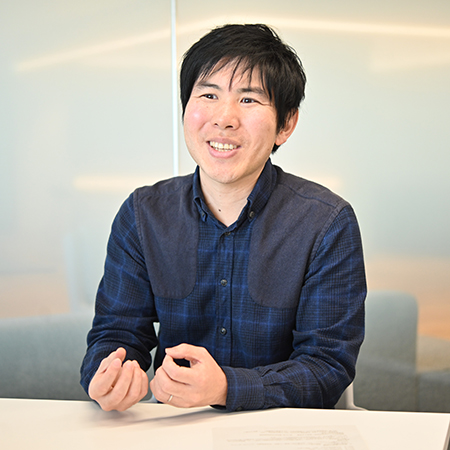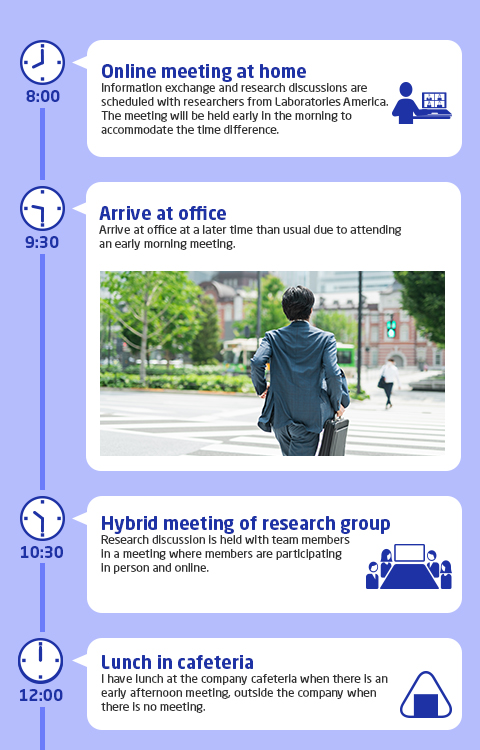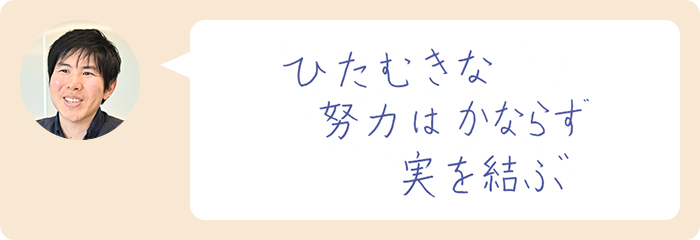Global Site
Breadcrumb navigation
Message for students 2025:Satoshi Yamazaki
April 9, 2025
Engaged in projects ranging from overseas demonstrations to generative AI research

Satoshi Yamazaki
Principal Researcher
Visual Intelligence Research Laboratories
After completing a doctorate program with theoretical research in condensed matter physics, Yamazaki joined NEC in 2014. In 2017, he moved to NEC APAC Pte. Ltd., where he worked on the implementation of a face recognition system in Singapore and Hawaii. After returning to NEC in 2021, he has conducted research and development on video data utilization technology that integrates video recognition AI with a large language model. His work covers areas ranging from core technology research to applied research and practical demonstrations.

Participation in the implementation of face recognition technology in Singapore
After joining NEC, I began by working on research and development in system management involving network virtualization technology. My responsibilities included building systems such as software-defined networking (SDN), which was a developing area during that period. After two years, I responded to an internal recruitment within the laboratory for members to participate in demonstration experiments of a face recognition system. Since my work and interests involved incorporating AI technologies like video analysis into systems, I applied for and accepted this position.
After my transfer, the nature of my work underwent a significant transformation. Although I was able to acclimate to the new research theme with the support of my team members, the most notable change was in my work location and culture. Due to the collaborative demonstration project with the Government of Singapore, I was reassigned to NEC APAC Pte. Ltd., headquartered in Singapore. In this capacity, I participated as a researcher and developer, providing support to the solution architect on site.
This assignment marked my first experience with the challenges specific to on-site demonstrations. Most issues stemmed from system incompatibility or inherent system limitations, demanding specialized troubleshooting skills. Unlike laboratory settings, on-site environments impose constraints on processing time and available resources, while also requiring adaptability to requests such as managing 100 cameras simultaneously.
Cultural differences in project execution were also evident. In Japan, actions are typically taken only after a thorough assessment of potential outcomes. Conversely, in Singapore, there is a more experimental approach—initiatives proceed once they are deemed feasible. Initially, this shift surprised me, but working within this environment proved to be an invaluable learning experience. It was during this period that I developed a proactive ability to anticipate and identify future challenges that continued to benefit my current research endeavors.
Drawing on my experience in Singapore, I contributed to the implementation of a body surface temperature screening system at five major airports in Hawaii beginning in 2020. This system, which integrates thermal camera technology, was adopted as a preventive measure against COVID-19. The successful deployment of this initiative was recognized with the 72nd Electrical Science and Engineering Promotion Award in 2024.

Integration of video recognition AI and LLM
After returning to NEC Laboratories in 2021, I concentrated on core technology research, with a focus on advancing data management techniques that seamlessly integrate video recognition AI with large language models (LLMs) or visual language models (VLMs). My specific research objective has been the development of AI capable of retrieving video scenes of interest specified by user queries. Notably, in 2023, I released a technology that identifies and extracts accident scenes from dashboard camera footage and generates textual descriptions of those scenes. This solution was conceived with potential applications in the insurance company in mind. Given the unpredictable nature of accidents as captured on video, my ongoing work involves training AI systems to recognize indicative features of accidents, including vehicle movement anomalies and debris dispersion.
My experience encompasses a broad spectrum of projects, ranging from applied to core technology research, including hands-on demonstrations. At NEC, there is a strong cohort of researchers who, like me, have expertise in both applied and core technology research, with some excelling at the highest levels across these fields. The environment fosters continuous growth, as there is always an opportunity to learn from those with exceptional proficiency.
Additionally, there are professionals who specialize in academic research, consistently publishing excellent papers. Notably, an increasing number of young researchers are choosing this path. I frequently approach my colleagues to seek clarification on complex topics, making use of the collaborative nature of our workplace.
Moreover, the business units at NEC are comprised of highly skilled individuals. With operations spanning government, finance, and retail sectors, each area benefits from specialists with deep and specific knowledge, providing ample learning opportunities for all involved.

Understanding key aspects from firsthand information that may not be accessible from an office
A critical aspect of my research involves achieving a clear understanding of the core issues at hand. For instance, practical challenges—such as insufficient precision—frequently arise during the implementation phase, making root cause analysis essential. Addressing recurring problems systematically enables a deeper comprehension over time. Resolving a single issue often has broader implications, potentially rectifying multiple related challenges simultaneously. Furthermore, pursuing in-depth solutions rather than temporary fixes to surface-level issues can drive technological advancement.
It is also common for unforeseen issues, not previously considered within the academic community, to emerge in practical applications. Promptly sharing these findings with the academic community represents a valuable contribution, and actively working toward their resolution can yield even greater benefits.
Perseverance is also important. In today’s rapidly evolving environment, expedited prototyping and continuous refinement based on customer feedback are vital for successful commercialization and market leadership. Often, true customer needs only become apparent through direct engagement and iterative development. Initiating an early prototype and incorporating user input is a fundamental process for effective application development.
Taking the initiative and engaging directly with present challenges is crucial. Every problem presents an opportunity; confronting them proactively lays the groundwork for future success.
- *The information posted on this website is the information at the time of publication.
A day at work


Message to my past self in my school days

Private column
Recently, I have developed an interest in colouring pictures. Initially, this activity was a way to spend time with my children, but after I purchased watercolour pencils, it has evolved into my serious hobby. While I am not good at drawing, colouring allows me to express creativity without the need for original illustrations. I appreciate the freedom to approach colouring in any manner I choose, balanced by certain inherent constraints. This preference for creativity under constraints likely aligns with my professional inclinations as well.
